Disclosure: Meeple Mountain received a free copy of this product in exchange for an honest, unbiased review. This review is not intended to be an endorsement.
They say that every city has its seedy underbelly. Seedy underbelly. Those words carry such negative connotations. Disreputable. Dirty. Unseemly. Criminal. Clearly the people that use such words have never visited the Black Lotus. Nobody that has ever spent a moment on her casino floor as it pulses with life or relaxed in one of her luxury suites would use the word “seedy” to describe the experience. Anybody that would describe the Black Lotus as dirty or unseemly has certainly never sat down and listened to Madame Peng sing. Her voice is transcendent. Frankly, their unkind words are a little insulting.
But they’re not entirely wrong. Managing such a lucrative enterprise sometimes requires getting a little dirty: greasing palms, airing dirty laundry, muckraking. And when necessary, a little wetwork. You can’t make an omelette without breaking a few eggs.
Overview
In the game of Shadows of Macao, the players are competing to build the most powerful triads. They will be sending their minions out to collect the resources and recruit the work force needed to build different Establishments in order to spread their influence throughout the titular city.
In between the players are 4 stacks of double-sided Character cards. On their turns, the players will be able to add Characters from the top of the stacks into their playing areas and gain access to the resources these Characters provide. These resources are used to either construct one of the random Establishments that will be available each game or to recruit other Characters (turn them to their active side) to gain access to their resource permanently (because using a Character’s resource when it is on its inactive side causes that card to be discarded). Recruiting a Character also gives players access to that Character’s unique ability.
As the players’ Character card engine begins to grow, the action picks up faster and faster until one of the end conditions is met at which point the players tally up their scores. The player with the highest score wins.
This is a very simplified explanation of the game. If you’d like to learn how Shadows of Macao is played in more detail, keep reading. Otherwise, feel free to skip ahead to the Thoughts section.
Setup
To set up a game of Shadows of Macao, first give each player a Widow card, which is placed in front of them blue side up. Then take the Character card deck and add a number of Widow cards to it based on player count and shuffle all of these together. This deck is then divided into 4 same-sized piles which are placed side by side in the center of the table blue side up.

Next, select a number of randomly drawn Establishment tiles (also based on player count) and place these blue side up nearby. Place the Deceased Widow cards off to the side. Then determine a start player and give them the start player token. With that, you’re ready to begin playing the game.
A Round of Play
On a player’s turn, they may perform one of three available actions: Contact an Informant, Recruit a New Member, or Open an Establishment. Let’s examine each of these in more detail.
Contacting an Informant: Take a Character card from the center display and add it to your personal display blue side up. You’re only allowed to have up to 5 cards blue side up at any given time so if the card that you are adding would cause the total to go over that amount, you would have to discard one of the other cards.
Recruit a New Member: Pay the cost shown on the bottom of the Character card in order to flip it over to its red (active) side. This card no longer takes up one of your limited spaces for blue cards.
Each Character card has a cost shown at the bottom of the card that tells you which collection of resources needs to be turned in so that the card can be flipped over as well as a number printed in a medallion that tells you how many victory points the card will be worth at the end of the game once it is flipped.
Each Character card also has an icon in its upper right hand corner that displays the resource that it provides. When paying to flip over a Character card, you spend the resources shown on other Character cards to pay for the cost. If any of the cards used were blue side up, they are discarded, but any red cards hang around.
It is worth noting here that the Widow card can be used as a wild. If the Widow card is used when it is blue side up then it is covered by a Deceased Widow Card, which will be worth 0 points at the end of the game, and will permanently take up one of your 5 blue side up Character card slots. Widows that have been flipped over, on the other hand, are permanent wilds but will be worth -2 points each at the end of the game.
To better illustrate all of this, let’s consider an example:

In this image, we have a Barkeep (let’s call him BK1) on the right that’s going to cost 1 bottle, 1 lantern, and 1 gun to flip over. On the left we have a Widow, a Dancer that provides a bottle, and another Barkeep that provides a lantern (BK2). By discarding the Dancer, BK2, and using the Widow as a wild card to cover the cost of the gun (and covering her up with a Deceased Widow card), we are then able to flip over BK1 to its red side where it now provides us with a permanent gun icon.
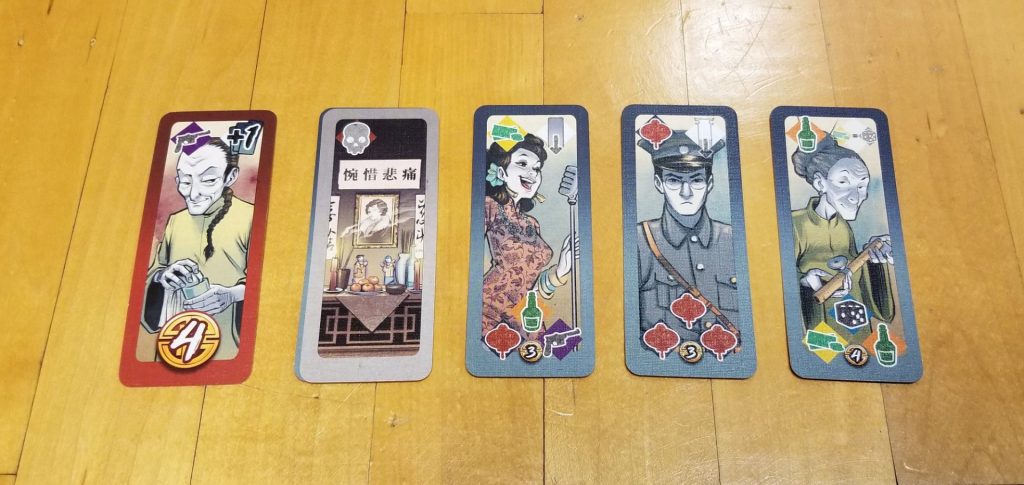
If you are an astute observer, you will no doubt have noticed the icons that appear in the upper right hand corners of the various Character cards. These icons represent each Character type’s unique ability that becomes active once the Character has been flipped to its red side. The Barkeep, for example, will reward you with an extra blue side up Character card slot. Now you can hold 6 blue side up Characters at a time!

Open an Establishment: Claim an unclaimed tile if you meet the criteria listed on it. These tiles are worth victory points at the end of the game. When you claim the tile, it is played into your play area yellow side up.
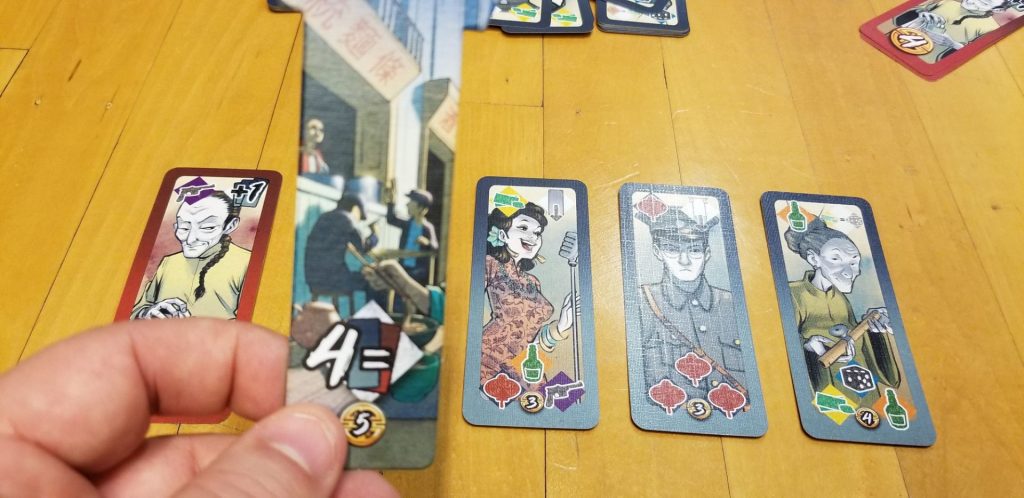
Bringing it to a Close
The end game is triggered in one of two ways: once a player has recruited their seventh Character or when all of the Establishments have been purchased (or reserved using one of the Character card’s abilities). Then the round is played out until it would be the start player’s turn again and the final scores are tallied. The person with the highest total wins. Points are earned from red side up Character cards and yellow side up Establishments.
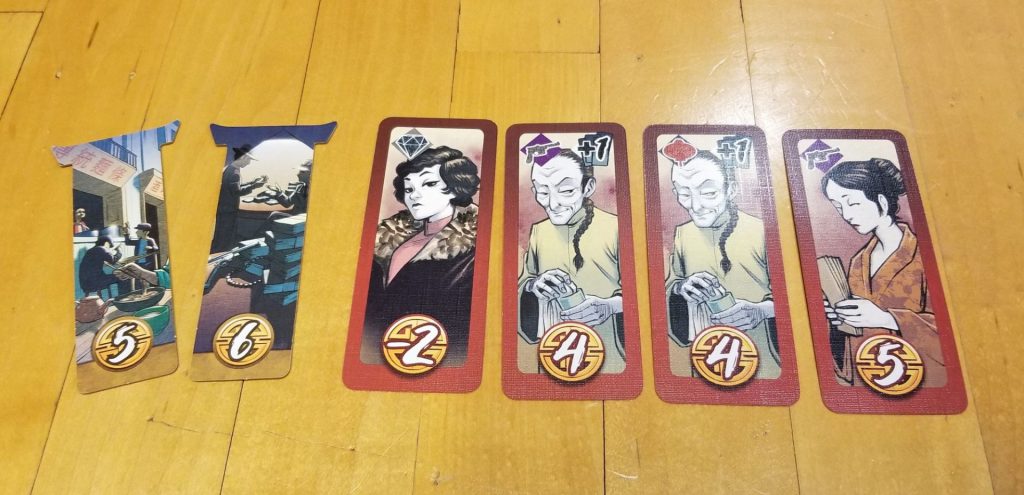
Thoughts
A few years ago, right before my first trip to Gen Con, I found myself facing a dilemma. It was going to be my wife’s birthday soon and I knew she’d be expecting something big. I had already purchased Trickerion for her and worked out a sneaky method to get it to Gen Con without her knowing, but I still wanted her to be surprised when it was presented to her. So to throw her off of the scent, I purchased a second, smaller game and worked with some friends to throw her a surprise party just a few days before we left for our trip. My hope was that she’d assume that the surprise party and subsequent gifts were all that she would be getting so that on the actual day of her birthday the gift of Trickerion would still be meaningful. That fake-out gift that I got her was Kanagawa. After playing Kanagawa several times, I fell in love with it and Charles Chevalier became a blip on my board game radar. So, when Shadows of Macao was offered to me for review, I jumped at the chance. Were my expectations too high? Would Shadows of Macao be everything that I hoped it would be?
Yes and no. Shadows of Macao is one of those classic examples of a game where the aesthetic just doesn’t mesh with the game play. At no time do I ever feel like I am managing a criminal enterprise. Even though the amazing artwork leads me in that direction, the game play never manages to get me there. So thematically, it’s a swing and a miss for me. And that’s not the only thing about Shadows of Macao that I found disappointing. Just take a look at this image and see if you can figure out what’s wrong:
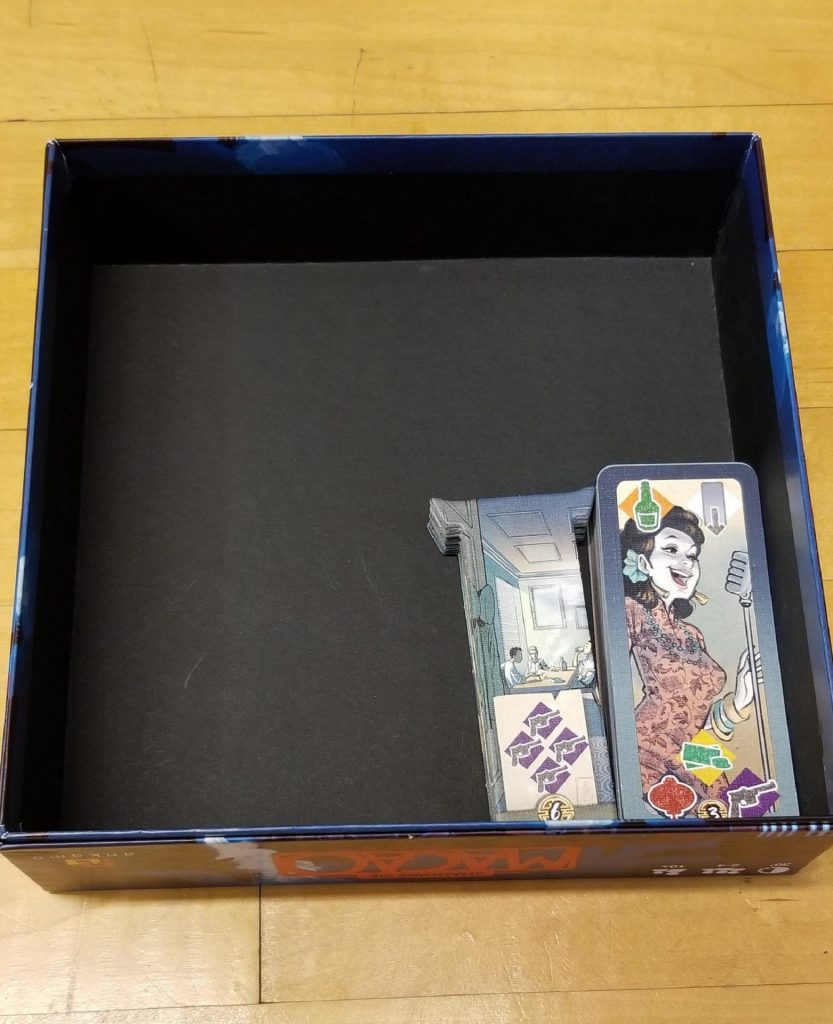
What you see here are all of the components for the game minus the rule book. Even when you factor in the thickness of the sprues that the Establishment tiles were punched out of, there’s still way too much wasted space. This game box could easily have been only half the size and worked twice as well. To quote one of my fellow writers, Tom Franklin, it “…rivals Splendor for Waste of Space Packaging.”
As if that isn’t bad enough on its own, there aren’t even any plastic bags included. Maybe I would have let that slide without mentioning it 20 years ago when the only measure was Catan, but in this day and age, it’s inexcusable. Two bags is all the game needs: one to hold the cards and the other to hold the Establishment tiles. Two tiny bags. Needless to say, before I’d even started playing the game for the first time, I was not very pleased with what I’d seen thus far.
Fortunately, once you actually start playing, all of those niggling component-related issues become inconsequential. Shadows of Macao is a very enjoyable game.
I’m a big fan of engine builders. As an old school Magic: the Gathering player, that feeling of starting off with nothing, the slow burn that follows, and the culminating explosion of activity really speaks to me. It’s exciting, simultaneously filling me with both anticipation and dread. “If this works, it’s going to be amazing. But what if it doesn’t? Everything rides on this next turn.” It’s like being on a roller coaster that has reached a plateau and is running out of steam, but there’s a dip up ahead. If you can reach that dip, the ride will continue. Shadows of Macao is full of these little moments. You’ll have everything lined up perfectly, ready to flip over a card or snag an Establishment tile, and all you need to pull it off is one specific icon. So you watch the four stacks of cards in the middle of the table just praying and hoping that nobody takes the card you really need or that, if they do, another card will flip up bearing the same icon.

It’s almost impossible to play Shadows of Macao without holding it up against Splendor as a comparison. Splendor may not have been the first game where you acquire temporary objects in order to gain permanent versions of those same objects in order to eventually score points but it is by far the most popular game that does so and that’s why it serves as a useful benchmark. Shadows of Macao does much of the same thing. What sets Shadows of Macao apart, though, is that you’re not just drafting the cards for their icons, but also for their unique abilities. This is a very important distinction.
Imagine if the poker chips in Splendor were double-sided. One side simply provides you with the gem printed on it (a ruby, for example). Now imagine that you had the ability to expend a different gem in order to flip this ruby onto its opposite side and that on the other side is a picture of 2 rubies or an icon that allows you to use this ruby chip as a wild. That’s kind of like what the unique abilities in Shadows of Macao do. Your choice of which card to draft isn’t just a choice between which icons are available, but also a choice between which special ability you’re eventually going to want to gain access to and that decision is going to inevitably inform all of your other decisions. The amount of game play that’s crammed into a small corner of this oversized box is pretty impressive.
Theme and wasted space notwithstanding, Shadows of Macao is a stellar game; it’s quick to set up, easy to teach, and doesn’t overstay its welcome. Clocking in around the 30 minute mark, it’s a perfect lunch time game (which is where I have personally played it the most). For me, the small footprint whilst playing, the ease of use, and each card having its own special power make the decision between playing this and Splendor a very easy one. Shadows of Macao wins, hands down. I highly recommend this game.


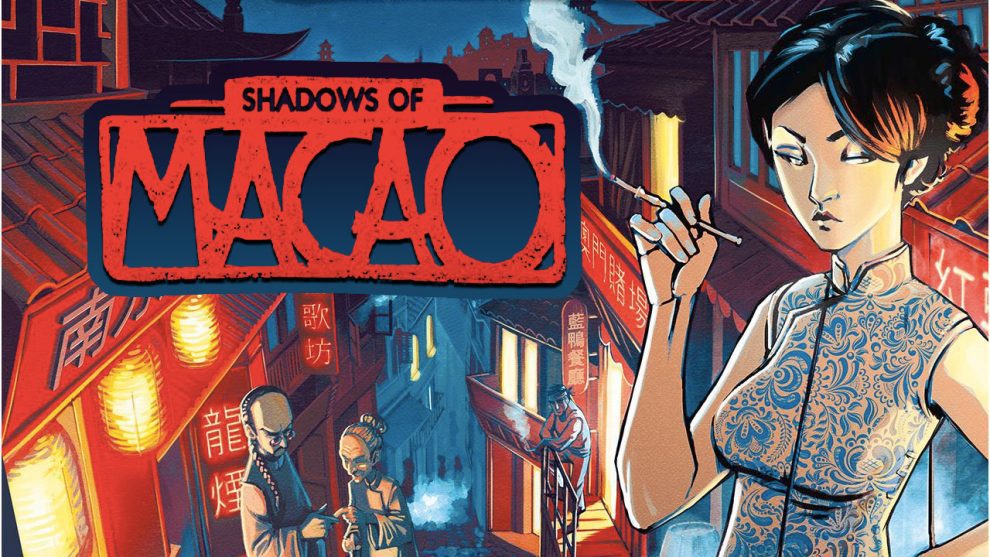








Add Comment